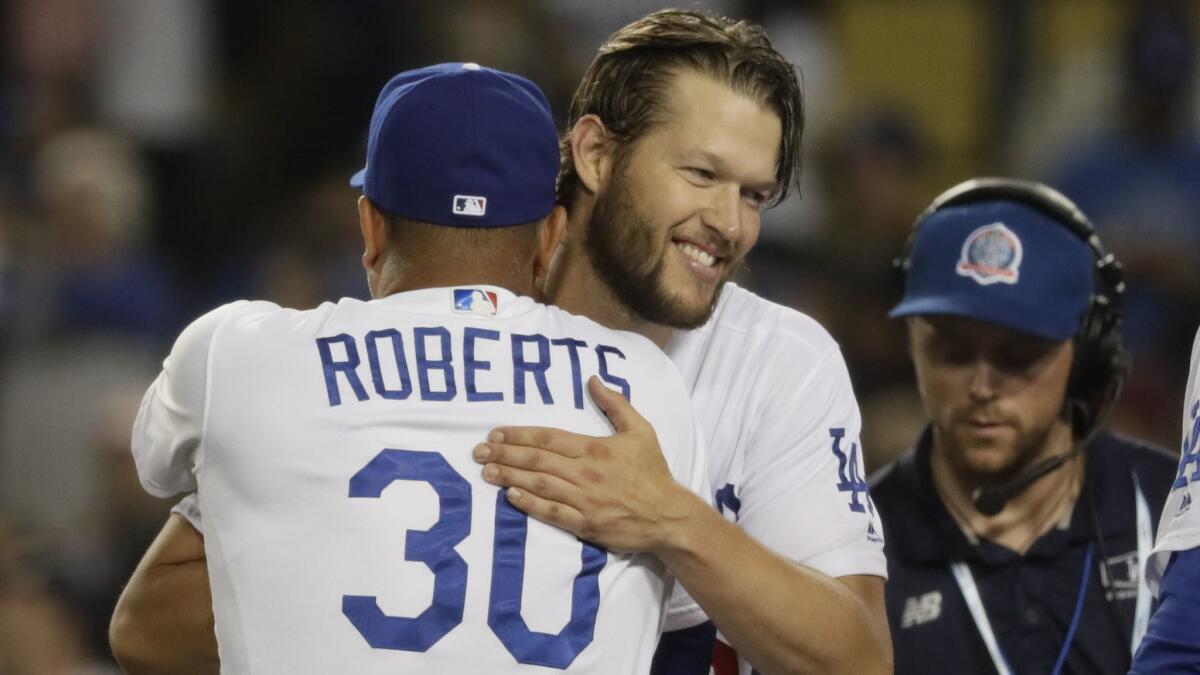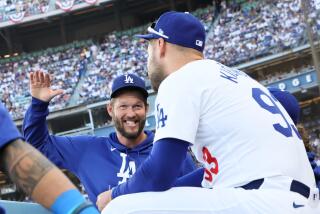The deal is done. So what’s next for Clayton Kershaw and the Dodgers?

The video package was forgotten amid the heartache and histrionics at the end of the Dodgers’ season. A round earlier, before getting trounced by the Boston Red Sox in the World Series, Clayton Kershaw sat in a darkened studio at Dodger Stadium and conceded the obvious.
The television staging featured mirrors reflecting his image, with the final product scored by brooding electro-pop, all designed to heighten the drama of his fastball velocity.
“I am throwing slower — I know that,” Kershaw told Fox Sports’ Ken Rosenthal. “I don’t know if that’s going to be for the rest of my career either. I firmly believe that I can get that back … I really do believe that there’s plenty left in the tank. I’m just going to spend an offseason figuring that out.”
On Friday afternoon, Kershaw cleared the only hurdle separating him from his winter of attempted revival. He agreed to a three-year, $93-million contract with the Dodgers, eschewing free agency to stay in the only professional home he has ever known.
Rather than opt out of the two years and $65 million left on the seven-year extension he signed in 2014, Kershaw leveraged his position into an additional $28 million plus potential bonuses.
The choice for the Dodgers was straightforward. The team retained a productive pitcher with a historic resume without adding a significant long-term burden. The contract does not, necessarily, make Kershaw a Dodger for life, but it increases the likelihood of a statue bearing his likeness at Chavez Ravine. After decades spent sparring with their stars, the Dodgers have cemented the face of their franchise.
More curious is Kershaw, a few months shy of turning 31, declining to enter the open market. The decision points to his loyalty to the organization, and his confidence in their capability to contend on a yearly basis. Kershaw has won enough individual accolades to fill the trophy case of an entire rotation. All he desires is a title; he has said on multiple occasions he might retire if his team wins the World Series.
Yet Kershaw has also emerged as a vocal member of the players union, criticizing opposing teams for tanking and championing the right of players to be paid fair value. This new deal with the Dodgers is what Kershaw has determined as his own value — a contract that rewards him for past achievement, places an elevated price on his present ability and concedes the risk of a lengthy commitment to his left arm.
“I would never want to sign anything I couldn’t live up to,” Kershaw said during a conference call on Friday.
Kershaw posted a 2.73 ERA in 2018, better than all but seven pitchers who threw at least 150 innings but his highest since 2010. He missed a month with a shoulder injury in May and hurt his back in June for the third season in a row. He avoided the disabled list from there, but finished the season facing significant questions about his declining fastball.
In 2015, when Kershaw struck out a career-best 301 batters and led the sport with 232 2/3 innings, his average fastball clocked at 93.6 mph, according to FanGraphs. In 2018, his fastball averaged 90.9. He threw more sliders than fastballs this season.
His slider sat at 88.2 mph and was often indistinguishable from the fastball, rival evaluators said. Not only were the pitches similar in velocity, but they also shared a similar shape. His fastball had a slight cutting action, while the slider lacked its downward bite from the past. “He’s almost like a one-pitch pitcher,” one National League scout said in September.
The decay of his arsenal coincided with another lackluster postseason. Kershaw pitched a pair of gems against Atlanta and Milwaukee, and closed out Game 7 at Miller Park. His ERA for October was still 4.20, a product of a three-inning faceplant in Milwaukee and two losses against Boston. The Red Sox posted a .907 on-base-plus-slugging percentage against Kershaw, not fooled by his curveball and ravenous against his other two options.
Near the conclusion of the regular season, one Dodgers official drew an alarming comparison, noting how Kershaw’s career might mirror that of former Seattle Mariners ace Felix Hernandez. The fastball velocity of Hernandez dipped from 94.1 mph in 2010 to 92.4 in 2014 to 90.5 mph in 2016.
Hernandez turned 31 in the spring of 2017. Up to that point, he had held hitters at bay with guile. The game caught up to him. Hernandez posted a 5.13 ERA in the past two seasons and lost his spot in the Seattle rotation this summer.
Kershaw experienced an accelerated, while less cruel, version of this trajectory in 2018. Upon his return from the disabled list June 23, he embarked on a 12-start stretch with a 2.15 ERA and 8.5 strikeouts per nine innings. He adapted to his decreased velocity by altering his sequences and using both sides of the plate. By September, when the scouting reports had revealed the changes, the hitters tagged him. His ERA for the final month was 3.89, with 7.5 strikeouts per nine innings.
“He’ll have to re-invent himself,” one National League scout said.
Kershaw is not doomed to follow Hernandez’s path. He could increase the use of his curveball, which he threw 16.4% of the time in 2018. A proliferation of curveballs confounded the Brewers in Game 5 of the NLCS.
Or he could follow the path of Pedro Martinez, whom Baseball Reference lists as the No. 1 comparable pitcher to Kershaw. As Martinez’s fastball faded later in his career, he leaned on a changeup to disarm hitters.
“The most important pitch in the second half of [Kershaw’s] career will be the changeup,” one Dodgers official said earlier this year.
Kershaw tinkers with the pitch each spring, insistent upon adding it to his repertoire, but pockets it during the season. He threw only 10 in 2018, according to Brooks Baseball — and some of those, Kershaw contended, were mis-categorized sliders. He threw none after injuring his shoulder and back.
The pitch does not come naturally to Kershaw. He suggested during an interview in April that the motion of the delivery contradicts the motion he makes with his fastball, slider and curveball. “I don’t have very big hands,” he explained, which prevents him from developing a proper feel for the circle grip and rules out the split grip made famous by Eric Gagne.
Kershaw considered the changeup a luxury, though he understood it might become a necessity.
“Maybe at 36,” Kershaw said. “Maybe next year. Who knows?”
Kershaw will have his winter to regroup and recharge. Next year arrives in a few months.
Twitter: @McCulloughTimes
More to Read
Are you a true-blue fan?
Get our Dodgers Dugout newsletter for insights, news and much more.
You may occasionally receive promotional content from the Los Angeles Times.











